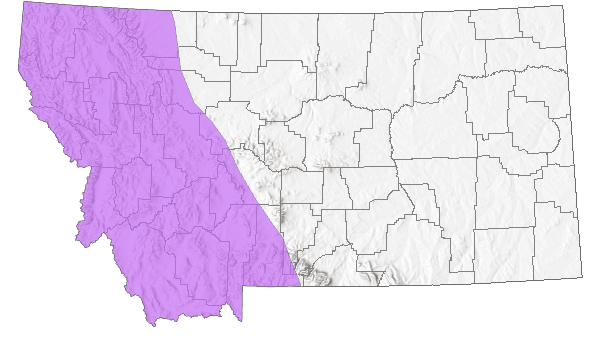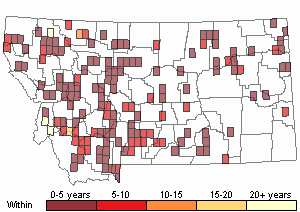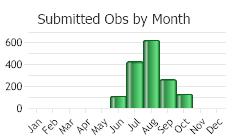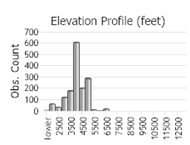View in other NatureServe Network Field Guides
NatureServe
Montana
Utah
Wyoming
Idaho
Wisconsin
British Columbia
South Carolina
Yukon
California
New York
Slender Pondweed - Potamogeton filiformis
Other Names:
Stuckenia filiformis
Native Species
Global Rank:
G5
State Rank:
SU
C-value:
6
Agency Status
USFWS:
USFS:
BLM:
External Links
General Description
PLANTS: Aquatic, rhizomatous perennials with roundish (terete), branched stems; (10-)20 to 60(-100) cm long. Lowest portions of the stem branch more than the upper portions. Turions are absent. Sources: Lesica et al. 2012; Haynes and Hellquist in Flora of North America (FNA) 2000.
LEAVES: Submersed leaves attach to the stipule and not directly to the stem. Submersed leaves are very slender or threadlike (filiform), 1 to 8 cm long by 1 to 2 mm wide, and tapering for the ultimate 1 mm. The lower stipules of the leaves are 5 to 15 mm long and sheath the stem. Floating leaves are absent. Source: Lesica et al. 2012.
INFLORESCENCE: Small flowers are arranged in distinct whorls on 1 to 5 cm long spike. Source: Lesica et al. 2012.
The specific epithet filiformis translates directly from Latin to mean threadlike, referring to the long, slender form of the leaves. Potamogeton is derived from the Greek words potamos meaning river and geiton meaning neighbor (Merriam-Webster 2019; Pilon et al. 2002).
Phenology
Slender Pondweed flowers from June through July (Hellquist et al. 2012).
Diagnostic Characteristics
Montana has 21
Potamogeton species. They are all aquatic perennials with submergent leaves, but some species also have floating leaves, often of a different shape. All species have small, sessile flowers arranged in a cylindrical spike with a long stem (peduncle) that grows from the axil of a leaf.
Many floras have split
Potamogeton into two genera based on molecular evidence and the following morphology (Haynes and Hellquist
FNA 2000; Giblin et al. [eds.] 2018):
Potamogeton
*Floating leaves present or absent.
*Submersed leaves: Stipule is free from the leaf blade, or if attached the fused (adnate) portion is 5 mm or less and no more than half the stipule’s length.
*Submersed leaf blades are translucent, not channeled, and are flat.
*Peduncle of the inflorescence is stiff and can project above the water.
*18 Montana species.
Stuckenia
*Floating leaves never present.
*Submersed leaves: At least two-thirds of the stipule is adnate to the base of the leaf, usually for more than 10 mm and it forms a sheath around the stem.
*Submersed leaf blades are opaque, channeled, and are turgid.
*Peduncle of the inflorescence is flexible and does not project above the water (is submersed).
*3 Montana species.
Slender Pondweed-Potamogeton filiformis, native
*Stems: Cylindrical (terete) and branched. Less branched above.
*Floating Leaves: absent.
*Submersed Leaves: Filiform, 1-8 cm long and 1-2 mm wide, and attached directly to the stipule (not the stem). Leaf tip acute to acuminate or blunt or asymmetrically notched. Leaf tapers only within the last 1 mm of the tip.
*Stipules: Lower stipule 5-15 mm long and sheathing. Tip of stipule extends as a ligule up to 20 mm beyond their junction with the base of the leaf blade.
*Spikes: 1-5 cm long with distinct whorls of flowers.
*Tepals: Brownish and 1-2 mm long.
*Achenes: 2-3 mm long and obscurely keeled with a minute beak.
*Rhizomes not tuberous.
*Often confused with Potamogeton vaginatus or Potamogeton pectinatus.
Sheathed Pondweed-Potamogeton vaginatus, native
*Stems: Cylindrical (terete) and branched.
*Floating Leaves: absent.
*Submersed Leaves: linear, 2-10 cm long and 1-2 mm wide, and attached directly to the stipule (not the stem).
*Stipules: Lower stipule 1-5 mm long and sheathing, brown, and swollen at the base. Tip of stipule extend as a ligule, 0-2mm beyond their junction with the base of the leaf blade.
*Spikes: 1-5 cm long with well-separated whorls of flowers.
*Tepals: Brownish-green and 1-2 mm long.
*Achenes: 2-3(-3.8) mm long and obscurely keeled and beaked.
*Often confused with Potamogeton filiformis or Potamogeton pectinatus.
Sago Pondweed-Potamogeton pectinatus, native
*Stems: Cylindrical (terete)and branched. Highly branches, especially above.
*Floating Leaves: absent.
*Submersed Leaves: Filiform, 1-10 cm long and <1 mm wide, and attached directly to the stipule (not the stem). Leaf tip acute to acuminate, apiculate, or mucronate on young plants. Leaf tapers within the last 3 mm of the tip.
*Stipules: Lower stipules 1.5-30 mm long, tightly sheathing, but not swollen. Tip of stipule extends as a ligule up to 20 mm beyond their junction with the base of the leaf blade.
*Spikes: 1-5 cm long with distinct whorls of flowers.
*Tepals: Brownish-green and 1-1.5 mm long.
*Achenes: 3-4 mm long and obscurely keeled with a slender, curved beak.
*Rhizomes tuberous.
*Often confused with Potamogeton filiformis or Potamogeton vaginata.
Blunt-leaved Pondweed-Potamogeton obtusifolius, native, SOC
*Stems: Slightly compressed and branched with globose glands at the nodes.
*Floating Leaves: absent.
*Submersed Leaves: Linear, 3-8 cm long and 2-4 mm wide, with a blunt tip, and attached directly to the stem at the base of the stipule.
*Stipules: 1-2 cm long, membranous, and sheathing.
*Spikes: About 1 cm long.
*Tepals: Green and about 1 mm long
*Achenes: Barely keeled and 3-3.5 mm long including the erect beak.
Curly-leaf Pondweed-Potamogeton crispus, exotic, noxious
*Stems: Slightly flattened and mostly straight.
*Floating Leaves: absent (though stems break off and float).
*Submersed Leaves: Mature leaf blades clasp the stem, are linear to oblong with wavy margins (like a lasagna noodle) and minute teeth. Leaves lack a stem (petiole).
Leafy Pondweed-Potamogeton foliosus, native
* Montana plants are variety foliosus.
*Stems: Slightly compressed and branched and lacking globose glands at the nodes.
*Floating Leaves: absent.
*Submersed Leaves: Linear, 1-4 cm long and about 1 mm wide, and attached directly to the stem at the base of the stipule.
*Stipules: 5-10 mm long and sheathing but frying above.
*Spikes: 1-6 mm long and capitate.
*Tepals: Green and =1 mm long.
*Achenes: 1.5-2 mm long. Abaxial keel is wing-like and beak is erect, 0.2-0.6 mm.
*A combination of linear leaves and fruits with an undulating, wing-like abaxial keel (not lateral keel) are most likely this species.Species Range
Montana Range
Range Descriptions

 Native
Native
Range Comments
Slender Pondweed is a circumboreal species and in North America it can be found south to California, Arizona, New Mexico, Nebraska and New York (Lesica et al. 2012).
Observations in Montana Natural Heritage Program Database
Number of Observations: 1601
(Click on the following maps and charts to see full sized version)
Map Help and Descriptions
Relative Density

Recency



 (Observations spanning multiple months or years are excluded from time charts)
(Observations spanning multiple months or years are excluded from time charts)
Habitat
Ecology
GROWTH LIMITATIONS
A Scotland based study of a eutrophic lake revealed a reduction of Slender Pondweed resulting from increased phosphate concentrations and phytoplankton densities (Jupp et al. 1977). Wave action, sediment effects, and waterfowl grazing also contribute to decreased production of Slender Pondweed. Waves caused by high winds alter Slender Pondweed densities either through damage of mature plants or by sediment disruption leading to displacement of seeds. Coarse sediments and algal blooms caused by waterfowl waste excretion lead to light attenuation making it harder for macrophytes such as Slender Pondweed to establish and spread.
HERBIVORY
Large, aquatic plants (macrophytes) are particularly important for the nutrition of waterfowl (Jupp et al. 1977). Potamogeton species fruits and tubers are known to be an especially significant part of their diet. Common consumers of Slender Pondweed include swans (Cygnus spp.), coots (Fulica spp.), and ducks (Anas and Aythya spp.).
ALLELOPATHIC POTENTIAL
Potamogeton species contain terpenoids and alkaloids, both potential allelochemicals (Gao et al. 2017). Allelochemicals are biochemicals released by plants that affect the growth, health, behavior, or population biology of other organisms around them (Gao et al 2017). Terpenoids in the forms of essential oils and monoterpenes strongly inhibit seed germination and plant growth (Fischer et al. 1994). Both terpenoids and alkaloids may cause plants to be bitter tasting or even toxic for herbivores (Harborne 1993).
The allelopathic effects of Potamogeton may be species specific (Gao et al. 2017). Effects were tested of two Potamogeton species on two algae species, Raphidocelis subcapitata and Microcystis aeruginosa. Potamogeton maackianus was found to show stronger inhibition on Microcystis aeruginosa while the inhibitory effects of Potamogeton malaianus were stronger on Raphidocelis subcapitata.
Reproductive Characteristics
FLOWERS
The flowers of Slender Pondweed are small and inconspicuous and arranged in distinct whorls on 1 to 5 cm long spikes (Lesica et al. 2012). The tepals are brownish and 1 to 2 mm long (Lesica et al. 2012).
FRUIT
The mature fruit of Slender Pondweed are obovoid achenes that are 2 to 3 mm long and obscurely keeled with a minute beak (Lesica et al. 2012). They are green when young and become dark brown with maturity (Haynes and Hellquist in FNA 2000; Hilty 2017).
LIFE CYCLE
Slender Pondweed colonies bloom in the summer or early fall after which the flowers are replaced by achenes (Hilty 2017).
HYBRIDIZATION
Where their ranges overlap, Slender Pondweed and Sago Pondweed are known to hybridize resulting in Potamogeton x suecicus (P. filiformis x P. pectinatus) (Preston et al. 1999; Haynes in Flora of North America 2019). The resulting hybrid is morphologically very similar to both its parent species.
Stewardship Responsibility
References
- Literature Cited AboveLegend:
 View Online Publication
View Online Publication Hitchcock, C.L. and A. Cronquist. 2018. Flora of the Pacific Northwest: An Illustrated Manual. Second Edition. Giblin, D.E., B.S. Legler, P.F. Zika, and R.G. Olmstead (eds). Seattle, WA: University of Washington Press in Association with Burke Museum of Natural History and Culture. 882 p.
Hitchcock, C.L. and A. Cronquist. 2018. Flora of the Pacific Northwest: An Illustrated Manual. Second Edition. Giblin, D.E., B.S. Legler, P.F. Zika, and R.G. Olmstead (eds). Seattle, WA: University of Washington Press in Association with Burke Museum of Natural History and Culture. 882 p. Lesica, P., M.T. Lavin, and P.F. Stickney. 2012. Manual of Montana Vascular Plants. Fort Worth, TX: BRIT Press. viii + 771 p.
Lesica, P., M.T. Lavin, and P.F. Stickney. 2012. Manual of Montana Vascular Plants. Fort Worth, TX: BRIT Press. viii + 771 p.
- Additional ReferencesLegend:
 View Online Publication
View Online Publication
Do you know of a citation we're missing? Culver, D.R. 1994. Floristic analysis of the Centennial Region, Montana. M.Sc. Thesis. Montana State University, Bozeman. 199 pp.
Culver, D.R. 1994. Floristic analysis of the Centennial Region, Montana. M.Sc. Thesis. Montana State University, Bozeman. 199 pp. Gillespie, D.M. 1966. Population studies of four species of mollusks in the Madison River, Yellowstone National Park. Ph.D. Dissertation. Bozeman, Montana: Montana State University. 43 p.
Gillespie, D.M. 1966. Population studies of four species of mollusks in the Madison River, Yellowstone National Park. Ph.D. Dissertation. Bozeman, Montana: Montana State University. 43 p. Horpestad, A.A. 1969. Factors affecting the distribution and abundance of aquatic macrophytes in parts of the Madison, Firehole and Gibbon Rivers. M.Sc. Thesis. Bozeman, MT: Montana State University. 88 p.
Horpestad, A.A. 1969. Factors affecting the distribution and abundance of aquatic macrophytes in parts of the Madison, Firehole and Gibbon Rivers. M.Sc. Thesis. Bozeman, MT: Montana State University. 88 p. Lesica, P., M.T. Lavin, and P.F. Stickney. 2022. Manual of Montana Vascular Plants, Second Edition. Fort Worth, TX: BRIT Press. viii + 779 p.
Lesica, P., M.T. Lavin, and P.F. Stickney. 2022. Manual of Montana Vascular Plants, Second Edition. Fort Worth, TX: BRIT Press. viii + 779 p. Marcoux, R.G. 1969. Fish populations in Big Spring Creek, Montana. M.Sc. Thesis. Bozeman, Montana: Montana State University
Marcoux, R.G. 1969. Fish populations in Big Spring Creek, Montana. M.Sc. Thesis. Bozeman, Montana: Montana State University McGuire, D. 1984. Community development and seasonal succession of aquatic macroinvertebrates in the Canyon Ferry Wildlife Management Area ponds. M.Sc. Thesis. Bozeman, MT: Montana State University. 77 p.
McGuire, D. 1984. Community development and seasonal succession of aquatic macroinvertebrates in the Canyon Ferry Wildlife Management Area ponds. M.Sc. Thesis. Bozeman, MT: Montana State University. 77 p. Rasmussen, S.M. 1968. Composition and structure of macrophyte vegetation of the Firehole River, Yellowstone National Park as related to physical and chemical factors. M.Sc. Thesis. Bozeman, MT: Montana State University. 44 p.
Rasmussen, S.M. 1968. Composition and structure of macrophyte vegetation of the Firehole River, Yellowstone National Park as related to physical and chemical factors. M.Sc. Thesis. Bozeman, MT: Montana State University. 44 p.
- Web Search Engines for Articles on "Slender Pondweed"





